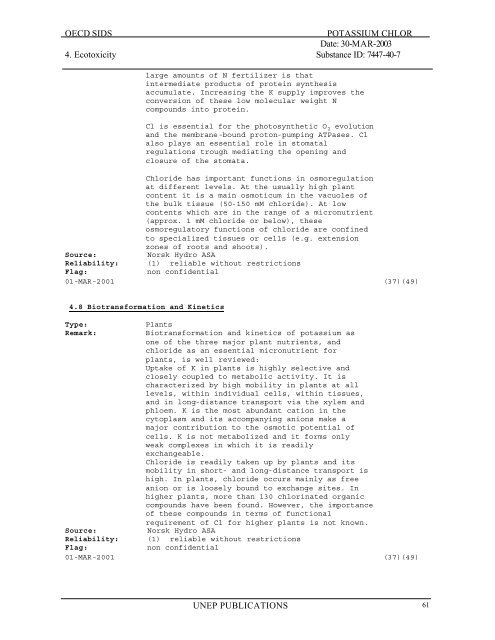POTASSIUM CHLORIDE CAS N°: 7447-40-7
POTASSIUM CHLORIDE CAS N°: 7447-40-7
POTASSIUM CHLORIDE CAS N°: 7447-40-7
Create successful ePaper yourself
Turn your PDF publications into a flip-book with our unique Google optimized e-Paper software.
OECD SIDS<br />
<strong>POTASSIUM</strong> CHLOR<br />
Date: 30-MAR-2003<br />
4. Ecotoxicity Substance ID: <strong>7447</strong>-<strong>40</strong>-7<br />
large amounts of N fertilizer is that<br />
intermediate products of protein synthesis<br />
accumulate. Increasing the K supply improves the<br />
conversion of these low molecular weight N<br />
compounds into protein.<br />
Cl is essential for the photosynthetic O 2 evolution<br />
and the membrane-bound proton-pumping ATPases. Cl<br />
also plays an essential role in stomatal<br />
regulations trough mediating the opening and<br />
closure of the stomata.<br />
Chloride has important functions in osmoregulation<br />
at different levels. At the usually high plant<br />
content it is a main osmoticum in the vacuoles of<br />
the bulk tissue (50-150 mM chloride). At low<br />
contents which are in the range of a micronutrient<br />
(approx. 1 mM chloride or below), these<br />
osmoregulatory functions of chloride are confined<br />
to specialized tissues or cells (e.g. extension<br />
zones of roots and shoots).<br />
Source:<br />
Norsk Hydro ASA<br />
Reliability: (1) reliable without restrictions<br />
Flag:<br />
non confidential<br />
01-MAR-2001 (37)(49)<br />
4.8 Biotransformation and Kinetics<br />
Type:<br />
Plants<br />
Remark:<br />
Biotransformation and kinetics of potassium as<br />
one of the three major plant nutrients, and<br />
chloride as an essential micronutrient for<br />
plants, is well reviewed:<br />
Uptake of K in plants is highly selective and<br />
closely coupled to metabolic activity. It is<br />
characterized by high mobility in plants at all<br />
levels, within individual cells, within tissues,<br />
and in long-distance transport via the xylem and<br />
phloem. K is the most abundant cation in the<br />
cytoplasm and its accompanying anions make a<br />
major contribution to the osmotic potential of<br />
cells. K is not metabolized and it forms only<br />
weak complexes in which it is readily<br />
exchangeable.<br />
Chloride is readily taken up by plants and its<br />
mobility in short- and long-distance transport is<br />
high. In plants, chloride occurs mainly as free<br />
anion or is loosely bound to exchange sites. In<br />
higher plants, more than 130 chlorinated organic<br />
compounds have been found. However, the importance<br />
of these compounds in terms of functional<br />
requirement of Cl for higher plants is not known.<br />
Source:<br />
Norsk Hydro ASA<br />
Reliability: (1) reliable without restrictions<br />
Flag:<br />
non confidential<br />
01-MAR-2001 (37)(49)<br />
UNEP PUBLICATIONS 61
















